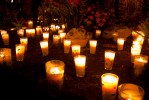El Día de los Difuntos, Ecuador
https://www.instagram.com/p/B3Uz2a7A7SZ/?utm_source=ig_web_button_share_sheet
Ecuador celebrates El Día de los Difuntos, or the Day of the Deceased, on Nov. 2, right after their smaller celebration of El Día de Todos los Santos on Nov. 1. While El Día de Todos los Santos is a quieter celebration that primarily focuses on children who have passed away, El Día de los Difuntos is much more upbeat. Families and friends gather to reminisce about their dearly departed relatives and partake in food and drink. One of those treats is guaguas de pan, a traditional Ecuadorian pastry made in the shape of a baby.

